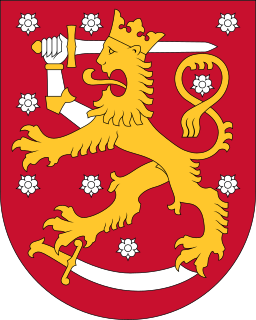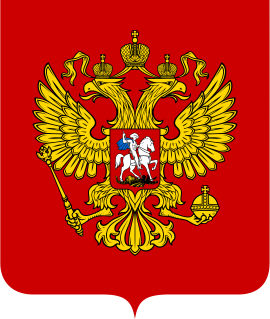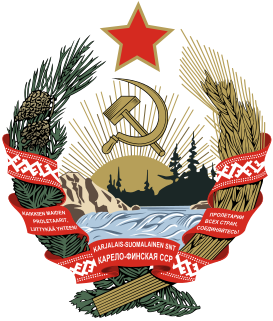
In heraldry, supporters, sometimes referred to as attendants, are figures or objects usually placed on either side of the shield and depicted holding it up.

Joensuu is a city and municipality in North Karelia, Finland, located on the northern shore of Lake Pyhäselkä at the mouth of the Pielinen River (Pielisjoki). It was founded in 1848. The population of Joensuu is 77,266, and the economic region of Joensuu has a population of 115,000. It is the 12th largest city in Finland. The nearest major city, Kuopio in North Savonia, is located 136 kilometres (85 mi) to the west. From Joensuu, the distance to Lappeenranta, the capital of South Karelia, is 233 kilometres (145 mi) along Highway 6.

In heraldry, the field (background) of a shield can be divided into more than one area, or subdivision, of different tinctures, usually following the lines of one of the ordinaries and carrying its name. Shields may be divided this way for differencing or for purposes of marshalling, or simply for style. The lines that divide a shield may not always be straight, and there is a system of terminology for describing patterned lines, which is also shared with the heraldic ordinaries. French heraldry takes a different approach in many cases from the one described in this article.
Karelia, the land of the Karelian people, is an area in Northern Europe of historical significance for Russia, Finland, and Sweden. It is currently divided between northwestern Russia and Finland.

The coat of arms of Ukraine is a blue shield with a gold trident. Officially referred to as the Emblem of the Royal State of Volodymyr the Great, or, colloquially, the tryzub, the insignia derives from the seal-trident of Volodymyr, the first Grand Prince of Kyiv.

The coat of arms of Finland is a crowned lion on a red field, the right foreleg replaced with an armoured human arm brandishing a sword, trampling on a sabre with the hindpaws. The coat of arms was originally created around the year 1580.

The coat of arms of Russia derives from the earlier coat of arms of the Russian Empire which was abolished with the Russian Revolution in 1917. Though modified more than once since the reign of Ivan III (1462–1505), the current coat of arms is directly derived from its medieval original, with the double-headed eagle having Byzantine and earlier antecedents. The general tincture corresponds to the early fifteenth-century standard.

Canting arms are heraldic bearings that represent the bearer's name in a visual pun or rebus.

The coat of arms of Karelia in Finland were first used in 1562, although the arms were probably presented at the burial of Gustav Vasa in 1560. The arms were used for the Swedish province of Karelia and they have been used continuously since then. Variations of the arms are still used in two regions of Finland: North Karelia and South Karelia, in which the North Karelian version is the original one. Present day North Karelia wasn't part of Swedish Kingdom back in 1562. Sweden gained the area from Russia after the Treaty of Stolbovo in 1617. For the most part, present day South Karelia had belonged to Sweden from 1323 onwards, since Treaty of Nöteborg.

The flag of the Republic of Karelia is a tricolour featuring three equal horizontal stripes of red, sky blue and green. The height to length ratio is 2:3.

The coat of arms of Iceland displays a silver-edged, red cross on blue shield, alluding to the design of the flag of Iceland. It is the only national arms to feature four supporters: the four protectors of Iceland (landvættir) as described in Heimskringla, standing on a block of columnar basalt. The bull (Griðungur) is the protector of northwestern Iceland, the eagle or griffin (Gammur) protects northeastern Iceland, the dragon (Dreki) protects the southeastern part, and the rock-giant (Bergrisi) is the protector of southwestern Iceland. Great respect was given to these creatures of Iceland, so much that there was a law during the time of the Vikings that no ship should bear grimacing symbols when approaching Iceland. This was so the protectors would not be provoked unnecessarily.

Portuguese heraldry encompasses the modern and historic traditions of heraldry in Portugal and the Portuguese Empire. Portuguese heraldry is part of the larger Iberian tradition of heraldry, one of the major schools of heraldic tradition, and grants coats of arms to individuals, cities, Portuguese colonies, and other institutions. Heraldry has been practiced in Portugal at least since the 11th century, however it only became standardized and popularized in the 16th century, during the reign of King Manuel I of Portugal, who created the first heraldic ordinances in the country. Like in other Iberian heraldic traditions, the use of quartering and augmentations of honor is highly representative of Portuguese heraldry, but unlike in any other Iberian traditions, the use of heraldic crests is highly popular.

The coat of arms of Haiti is the national coat of arms of the Republic of Haiti. It was originally introduced in 1807, and it has appeared in its current form since 1986. Since this Haitian national symbol does not conform to the rules of heraldry for a traditional coat of arms, then it could be considered a national emblem instead.

The emblem of the Karelo-Finnish Soviet Socialist Republic was adopted on February 10, 1941 by the government of the Karelo-Finnish Soviet Socialist Republic and used until it was absorbed into the Russian Soviet Federative Socialist Republic in 1956.

A crown is often an emblem of a sovereign state, usually a monarchy, but also used by some republics.

The coat of arms of Dominica was adopted on July 21, 1961. It consists of a shield with two guardian sisserou parrots bracing the shield atop of which is a lion passant. The quarters of the shield depict a canoe, a banana tree, a palm and a frog of the native species known as the mountain chicken. Below the shield is the national motto: Apres Bondie C'est La Ter.

The bear as heraldic charge is not as widely used as the lion, boar or other beasts.

Icelandic heraldry is the study of coats of arms and other insignia used in Iceland. It belongs to the German-Nordic heraldic tradition, as the heraldry of Iceland has been primarily influenced by the heraldic traditions of Norway, Denmark and other Nordic countries. Iceland does not have a strong sense of heraldic tradition, however, because the country lacks a governing body to oversee this. As a result, coats of arms registered as such are virtually nonexistent in modern Iceland. While many municipalities use more or less heraldic logos, there are no heraldic standards to which these must adhere, and they are registered as graphic designs rather than as coats of arms.

The Republic of Uhtua was an unrecognized state, with the focus of a state led by Finns. It existed from 1919 to 1920, created out of five Volosts in the Kemsky Uyezd of the Arkhangelsk Governorate, now in the Republic of Karelia. The capital of the republic was the village of Uhtua.

The national emblem of the Karelian Autonomous Soviet Socialist Republic was adopted in 1937 by the government of the Karelian Autonomous Soviet Socialist Republic. The emblem is identical to the emblem of the Russian Soviet Federative Socialist Republic.
















